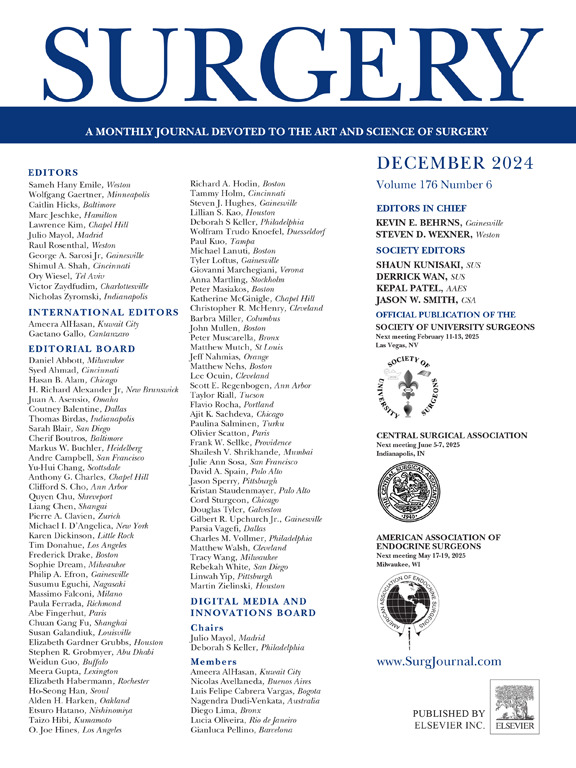Prognostic value of immune infiltration in colorectal cancer: Development of a histopathology-related immunoscore via multiplexed immunohistochemistry
IF 3.2
2区 医学
Q1 SURGERY
引用次数: 0
Abstract
Background
Our objective was to evaluate the prognostic value of immune infiltration within the intratumoral and peritumoral tissues and to establish a novel histopathology-related immunoscore associated with postoperative colorectal cancer prognosis.
Methods
In the tissue microarrays, a total of 104 patients with colorectal cancer were enrolled and randomly assigned to the derivation cohort (n = 61) or the validation cohort (n = 43). Eighteen prognostic immune biomarkers in both intratumoral and peritumoral tissues were examined by the multiplexed immunohistochemistry method, with quantification performed through digital pathology. The histopathology-related immunoscore score was constructed using least absolute shrinkage and selection operator Cox analysis by selected immune features. On the basis of the Cox regression analysis, 3 predictive models were established. Harrell C-statistics were used to assess the performance of those models.
Results
The area under the curve was 0.743 (confidence interval, 0.457–1.000) in the derivation cohort and 0.739 (confidence interval, 0.538–0.940) in the validation cohort. Subsequently, the groups were classified on the basis of the optimal cutoff value, with the high-risk group exhibiting a poorer prognosis. Furthermore, 3 predictive clinical models were constructed, incorporating the significant risk factors and histopathology-related immunoscore score. The first model incorporating both histopathology-related immunoscore score and statistically significant factors identified through univariate analysis demonstrated superior predictive capability for survival across all 3 models, with an area under the curve of 0.852 and C-index of 0.837.
Conclusion
The histopathology-related immunoscore score offers a novel means of estimating of survival in patients with colorectal cancer. These findings indicated that the immunoscore and the clinical factors might serve as complementary tools to TNM staging to improve the accuracy of patient survival prediction.

结直肠癌免疫浸润的预后价值:通过多重免疫组化技术开发组织病理学相关免疫分数
我们的目的是评估肿瘤内和肿瘤周围组织内免疫浸润的预后价值,并建立一种与结直肠癌术后预后相关的新型组织病理学相关免疫评分。方法采用组织微阵列技术,共纳入104例结直肠癌患者,随机分为衍生组(n = 61)和验证组(n = 43)。采用多重免疫组织化学方法检测肿瘤内和肿瘤周围组织中的18种预后免疫生物标志物,并通过数字病理学进行量化。组织病理学相关的免疫评分评分采用最小绝对收缩和选择算子Cox分析选定的免疫特征。在Cox回归分析的基础上,建立了3个预测模型。使用Harrell c统计量来评估这些模型的性能。结果衍生队列的曲线下面积为0.743(置信区间为0.457 ~ 1.000),验证队列的曲线下面积为0.739(置信区间为0.538 ~ 0.940)。随后,根据最佳截断值进行分组,高危组预后较差。结合显著危险因素和组织病理学相关免疫评分,构建3个预测临床模型。第一个结合组织病理学相关免疫评分评分和单变量分析确定的统计学显著因素的模型在所有3个模型中均显示出较好的生存预测能力,曲线下面积为0.852,c指数为0.837。结论组织病理学相关免疫评分为评估结直肠癌患者的生存提供了一种新的方法。这些结果表明,免疫评分和临床因素可以作为TNM分期的补充工具,以提高患者生存预测的准确性。
本文章由计算机程序翻译,如有差异,请以英文原文为准。
求助全文
约1分钟内获得全文
求助全文
来源期刊

Surgery
医学-外科
CiteScore
5.40
自引率
5.30%
发文量
687
审稿时长
64 days
期刊介绍:
For 66 years, Surgery has published practical, authoritative information about procedures, clinical advances, and major trends shaping general surgery. Each issue features original scientific contributions and clinical reports. Peer-reviewed articles cover topics in oncology, trauma, gastrointestinal, vascular, and transplantation surgery. The journal also publishes papers from the meetings of its sponsoring societies, the Society of University Surgeons, the Central Surgical Association, and the American Association of Endocrine Surgeons.
 求助内容:
求助内容: 应助结果提醒方式:
应助结果提醒方式:


